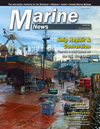
Page 25: of Marine News Magazine (March 2020)
Workboat Conversion & Repair
Read this page in Pdf, Flash or Html5 edition of March 2020 Marine News Magazine
on the inland waterways. For far too long, appropriation bills such as INFRA and BUILD programs and authoriz- ing legislation like the FAST Act and WRDA have un- derfunded inland facilities. Infrastructure projects sought by inland facilities are far less costly than the minimum required for those programs, but the composite result pro- vided by potentially funding these projects could be expo- nentially bene? cial to the nation’s transportation network.
IRPT has undertaken a legislative initiative of proposing to Congress an Inland Port and Terminal Grant Program to level the competitive playing ? eld. This program would be similar to MarAd’s small shipyard grant program, in that the program would be administered by MarAd, would adhere to 60-day submission and 120-day award distribution require- ments, and would include both private and public facilities.
The program would differ from the small shipyard grant program in that funds could be used to construct build- ings, physical facilities, purchase equipment, etc.; and funds could be used for ? xed landside infrastructure projects, such as docks, wharves, piers and road and rail improvements.
The program would also differ from the Marine Highways program, in that the program would extend to both private and public entities, would be available for ? xed landside infrastructure projects such as those mentioned above, and would extend to liquid and dry bulk cargoes.
Most of the discretionary grant programs for federal fund- ing assistance currently require a public sponsor, yet many of the facilities moving the nation’s freight are not located with- in a public port or they are located in rural areas in which the local public entities have very limited staff and resources. In such situations it is often dif? cult for a private terminal to se- cure a public sponsor in order to be eligible for federal fund- ing assistance, since securing a public sponsor often means that the sponsor must spend time and resources to adminis- ter the grant, perform audits and carry out other tasks.
Private terminals on the inland waterways create jobs, relieve landside traf? c congestion, reduce landside fuel consumption and emissions and avoid wear and tear on roads, bridges and rails no less than their public port coun- terparts. It is therefore, a bene? t to the general public in terms of job creation, safety, environment and cost savings to allow private terminal facilities to be eligible for federal funding assistance.
The inland and smaller coastal ports and private termi- nals are proud of the role that they play in our nation’s freight transportation system. They ask that this role be appropriately recognized as the nation plans its freight transportation strategy for the years ahead.
www.marinelink.com

 24
24

 26
26
